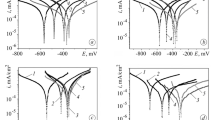We study the efficiency of inhibition of corrosion processes in the aluminum alloy placed in an aqueous solution of ethylene glycol by an ecologically friendly rhamnolipid biocomplex obtained as the product of biosynthesis of the Pseudomonas sp. PS-17 strain. It is shown that the biogenic inhibitor added to an aqueous solution of ethylene glycol decreases the rates of both the anodic and cathodic reactions and makes the charge-transfer resistance of aluminum alloy 2.6 times higher, which indicates the possibility of formation of durable protective films on the metal as a result of the adsorption of inhibitor molecules and the formation of complex compounds with aluminum cations. It is shown that the rhamnolipid biocomplex is an efficient corrosion inhibitor on freshly formed surfaces of the aluminum alloy, as indicated by an increase in the rate of its repassivation.





Similar content being viewed by others
References
N. B. Kirilenko, Automobile Maintenance Materials [in Russian], Akademiya, Moscow (2012).
N. N. Ivanchenko, A. A. Skurudin, and M. D. Nikitin, Cavitation Fractures in Diesel Engines [in Russian], Mashinostroenie, Leningrad (1970).
N. S. Dempster, “Corrosion of aluminum alloy in glycol-water cooling systems,” Corrosion, 15, No. 8, 13–16 (1959).
A. Yu. Pokhmurs’kyi, B. P. Rusyn, and Yu. V. Obukh, “Evaluation of the influence of pit-like defects on the strength of D16T sheet alloy,” Fiz.-Khim. Mekh. Mater., 48, No. 1, 95–99 (2012); English translation: Mater. Sci., 48, No. 1, 101–105 (2012).
J. Weber, “Inhibition of the corrosion of industrial cooling systems: report prepared for the European Federation of Corrosion Working Party on inhibitors,” Br. Corros. J., 14, No. 2, 69–77 (1979).
V. N. Esenin, L. I. Denisovich, and А. А. Stepanov, Corrosion Inhibitor for Low-Freezing Cooling Liquids [in Russian], Patent of the Russian Federation N2302479, MPK C23F 11/10, C09K 5/20, Publ. on 10.07.2007, Byul. No. 19.
I. I. Rozenfel’d, Corrosion Inhibitors [in Russian], Khimiya, Moscow (1977); English translation: I. L. Rozenfeld, Corrosion Inhibitors, McGraw-Hill (1981).
L.C. Rowe, “Application of inhibitors in automobiles and their environment,” in: Corrosion Inhibitors, NACE, Houston (1973), pp. 173–187.
Е. V. Karpenko, Т. Ya. Pokin’broda, R. G. Makitra, and Е. Ya. Pal’chikova, “Optimal methods for the extraction of biogenic surface-active rhamnolipids,” Zh. Obshch. Khim., 12, 2011–2014 (2009).
Е. V. Karpenko, V. А. Voloshinets, А. F. Grabarovskaya, I. V. Semenyuk, and О. Ya. Karpenko, “Colloid-chemical characteristics of the products of biosynthesis of the Рseudomonas sp. PS-17 strain,” Vopr. Khim. Khim. Tekhnol., No. 2, 34–39 (2012).
N. A. Khop’yak, O. V. Karpenko, and R. I. Vil’danova, “Toxicological-hygienic and ecological evaluation of the 'Polikom' surface-active biopreparation,” Gigiena Naselen. Mist., No. 60, 167–172 (2012).
V. I. Pokhmurskii, I. M. Zin', А. І. Kondyr, and О. P. Khlopyk, Method of Express Evaluation of the Efficiency of Corrosion Inhibitors under the Conditions of Mechanical Fracture of Passive Films on the Metal Surfaces [in Ukrainian], Patent of Ukraine No. 81047, MPK G01N 17/00, C23F 11/00, Publ. on 25.06.2013, Byul. No. 12.
I. M. Zin, V. I. Pokhmurskii, S. A. Korniy, O. V. Karpenko, S. B. Lyon, O. P. Khlopyk, and M. B. Tymus, “Corrosion inhibition of aluminum alloy by rhamnolipid biosurfactant derived from Pseudomonas sp. PS-17,” Anti-Corros. Meth. Mater., 65, No. 6, 517–527 (2018).
S. А. Kornii, V. І. Pokhmurs’kyi, V. I. Kopylets’, І. М. Zin’, and N. R. Chervins’ka, “Quantum-chemical analysis of the electronic structures of inhibiting complexes of rhamnolipid with metals,” Fiz.-Khim. Mekh. Mater., 52, No. 5, 7–18 (2016); English translation: Mater. Sci., 52, No. 5, 609–619 (2017).
Y. Yin, T. Liu, S. Chen, T. Liu, and S. Cheng, “Structure stability and corrosion inhibition of superhydrophobic film on aluminum in seawater,” Appl. Surf. Sci., 255, 2978–2984 (2008).
J. R. Sin, Investigation of the Corrosion and Tribocorrosion Behavior of Metallic Biomaterials, PhD Thesis, Luleå University of Technology (2015).
Author information
Authors and Affiliations
Corresponding author
Additional information
Translated from Fizyko-Khimichna Mekhanika Materialiv, Vol. 55, No. 5, pp. 21–26, September–October, 2019.
Rights and permissions
About this article
Cite this article
Zin’, І.М., Pokhmurs’kyi, V.І., Khlopyk, О.P. et al. Inhibition of the Corrosion of Aluminum Alloy in Aqueous Solution of Ethylene Glycol by the Rhamnolipid Biocomplex. Mater Sci 55, 633–639 (2020). https://doi.org/10.1007/s11003-020-00353-w
Received:
Published:
Issue Date:
DOI: https://doi.org/10.1007/s11003-020-00353-w




